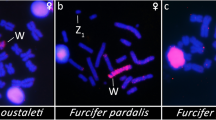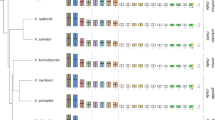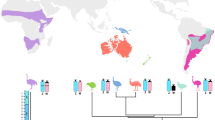Abstract
Reptiles show a diverse array of sex chromosomal systems but, remarkably, the Z sex chromosomes of chicken are homologous to the ZW sex chromosomes of a species of gecko, Gekko hokouensis, suggesting an ancient but common origin. This is in contrast to the ZW sex chromosomes of snakes and a species of soft-shelled turtle, Pelodiscus sinensis, which are nonhomologous to those of chicken or each other and appear to have been independently derived. In this paper, we determine what homology, if any, the sex chromosomes of the Australian dragon lizard Pogona vitticeps shares with those of snake and chicken by mapping the dragon homologs of five snake Z chromosome genes (WAC, KLF6, TAX1BP1, RAB5A, and CTNNB1) and five chicken Z chromosome genes (ATP5A1, GHR, DMRT1, CHD1, and APTX) to chromosomes in the dragon. The dragon homologs of snake and chicken sex chromosome genes map to chromosomes 6 and chromosome 2, respectively, in the dragon and that DMRT1, the bird sex-determining gene, is not located on the sex chromosomes of P. vitticeps. Indeed, our data show that the dragon homolog to the chicken Z chromosome is likely to be wholly contained within chromosome 2 in P. vitticeps, which suggests that the sex-determining factor in P. vitticeps is not the sex-determining gene of chicken. Homology between chicken Z chromosome and G. hokouensis ZW chromosome pairs has been interpreted as retention of ancient ZW sex chromosomes in which case the nonhomologous sex chromosomes of snake and dragons would be independently derived. Our data add another case of independently derived sex chromosomes in a squamate reptile, which makes retention of ancient sex chromosome homology in the squamates less plausible. Alternatively, the conservation between the bird Z chromosome and the G. hokouensis ZW chromosomes pairs is coincidental, may be an example of convergent evolution, its status as the Z chromosome having been independently derived in birds and G. hokouensis.



Similar content being viewed by others
Abbreviations
- BAC:
-
bacterial artificial chromosomes
- DAPI:
-
4′,6-diamidino-2-phenylindole
- dATP:
-
2′-deoxyadenosine 5′-triphosphate
- dCTP:
-
2′-deoxycytidine 5′-triphosphate
- dGTP:
-
2′-deoxyguanosine 5′-triphosphate
- DNA:
-
deoxyribonucleic acid
- dNTP:
-
deoxynucleotide triphosphate
- dUTP:
-
2′-deoxyuridine 5′-triphosphate
- FISH:
-
fluorescent in situ hybridization
- GSD:
-
genotypic sex determination
- HEPES:
-
4-(2-hydroxyethyl)-1-piperazineethanesulfonic acid
- Overgo:
-
overlapping oligonucleotides
- PCR:
-
polymerase chain reaction
- SSC:
-
standard saline citrate
- TSD:
-
temperature-dependent sex determination
- v/v :
-
volume/volume
References
Barske LA, Capel B (2008) Blurring the edges in vertebrate sex determination. Curr Opin Genet Dev 18:499–505
Becak W, Becak M (1969) Cytotaxonomy and chromosomal evolution in Serpentes. Cytogenetics 8:247–262
Becak W et al (1964) Close karyological kinship between the reptilian suborder Serpentes and the class Aves. Chromosoma 15:606–617
Chowdhary B et al (1998) Emerging patterns of comparative genome organization in some mammalian species as revealed by Zoo-FISH. Genome Res 8:577–589
Ezaz T et al (2005) The dragon lizard Pogona vitticeps has ZZ/ZW micro-sex chromosomes. Chromosome Res 13:763–776
Ezaz T et al (2006) Relationships between vertebrate ZW and XY sex chromosome systems. Curr Biol 16:R736–R743
Ezaz T et al (2008) A simple non-invasive protocol to establish primary cell lines from tail and toe explants for cytogenetic studies in Australian dragon lizards (Squamata: Agamidae). Cytotechnology 58:135–139
Ezaz T et al (2009) Molecular marker suggests rapid changes of sex-determining mechanisms in Australian dragon lizards. Chromosome Res 17:91–98
Georges A et al (2009) Are reptiles predisposed to temperature-dependent sex determination? Sex Dev (in press)
Graves JAM (2008) Weird animal genomes and the evolution of vertebrate sex and sex chromosomes. Annu Rev Genet 42:565–586
Graves JAM, Shetty S (2001) Sex from W to Z: evolution of vertebrate sex chromosomes and sex determining genes. J Exp Zool 290:449–462
Kawagoshi T et al (2009) The ZW micro-sex chromosomes of the chinese soft-shelled turtle (Pelodiscus sinensis, Trionychidae, Testudines) have the same origin as chicken chromosome 15. Cytogenet Genome Res 125:125–131
Kawai A et al (2007) Different origins of bird and reptile sex chromosomes inferred from comparative mapping of chicken Z-linked genes. Cytogenet Genome Res 117:92–102
Kawai A et al (2009) The ZW sex chromosomes of Gekko hokouensis (Gekkonidae, Squamata) represent highly conserved homology with those of avian species. Chromosoma 118:43–51
Matsubara K et al (2006) Evidence for different origin of sex chromosomes in snakes, birds, and mammals and step-wise differentiation of snake sex chromosomes. Proc Natl Acad Sci USA 103:18190–18195
Matsuda Y et al (2005) Highly conserved linkage homology between birds and turtles: bird and turtle chromosomes are precise counterparts of each other. Chromosome Res 13:601–615
Nanda I, Schmid M (2002) Conservation of avian Z chromosomes as revealed by comparative mapping of the Z-linked aldolase B gene. Cytogenet Genome Res 96:176–178
Nanda I et al (2002) Comparative mapping of Z-orthologous genes in vertebrates: implications for the evolution of avian sex chromosomes. Cytogenet Genome Res 99:178–184
Ohno S (1967) Sex chromosomes and sex-linked genes. Springer, Heidelberg
Ohno S et al (1964) Chromosomal uniformity in the avian subclass Carinatae. Chromosoma 15:280–288
Organ C, Janes DE (2008) Sex chromosome evolution in Sauropsids. Integr Comp Biol 48:512–519
Pokorná M, Kratochvíl L (2009) Phylogeny of sex-determining mechanisms in squamate reptiles: are sex chromosomes an evolutionary trap? Zool J Linn Soc 156:168–183
Quinn AE et al (2009) Extension, single-locus conversion, and physical mapping of sex chromosome sequences identify the Z microchromosome and pseudo-autosomal region in a dragon lizard, Pogona vitticeps. Heredity: Accepted, September 1, 2009
Quinn AE et al (2007) Temperature sex reversal implies sex gene dosage in a reptile. Science 316:411
Radder RS et al (2008) Genetic evidence for co-occurrence of chromosomal and thermal sex-determining systems in a lizard. Biol Lett 4:176–178
Ross M et al (1999) Screening large-insert libraries by hybridization. Current protocols in human genetics. Wiley, New York, pp 5.6.1–5.6.32
Sarre SD et al (2004) The ends of a continuum: genetic and temperature-dependent sex determination in reptiles. Bioessays 26:639–645
Schmid M et al (2005) Second report on chicken genes and chromosomes 2005. Cytogenet Genome Res 109:415–479
Shetty S et al (1999) Comparative painting reveals strong chromosome homology over 80 million years of bird evolution. Chromosome Res 7:289–295
Singh L (1972) Evolution of karyotypes in snakes. Chromosoma 38:185–236
Smith CA et al (2009) The avian Z-linked gene DMRT1 is required for male sex determination in the chicken. Nature 461:267–271
Stiglec R et al (2007) A new look at the evolution of avian sex chromosomes. Cytogenet Genome Res 117:103–109
Veyrunes F et al (2008) Bird-like sex chromosomes of platypus imply recent origin of mammal sex chromosomes. Genome Res 18:965–973
Acknowledgements
We thank Vidushi Patel and Denis O'Meally for the assistance in the laboratory. All experiments were performed with the approval of the University of Canberra Animal Experimentation Ethics Committee (Proposal CEAE 04/04). This work is supported by the Australian Research Council Discovery Grant (DP0881196) awarded to S.S., A.G., and Scott V. Edwards.
Author information
Authors and Affiliations
Corresponding author
Additional information
Responsible Editor: Herbert Macgregor.
Rights and permissions
About this article
Cite this article
Ezaz, T., Moritz, B., Waters, P. et al. The ZW sex microchromosomes of an Australian dragon lizard share no homology with those of other reptiles or birds. Chromosome Res 17, 965–973 (2009). https://doi.org/10.1007/s10577-009-9102-6
Received:
Revised:
Accepted:
Published:
Issue Date:
DOI: https://doi.org/10.1007/s10577-009-9102-6




